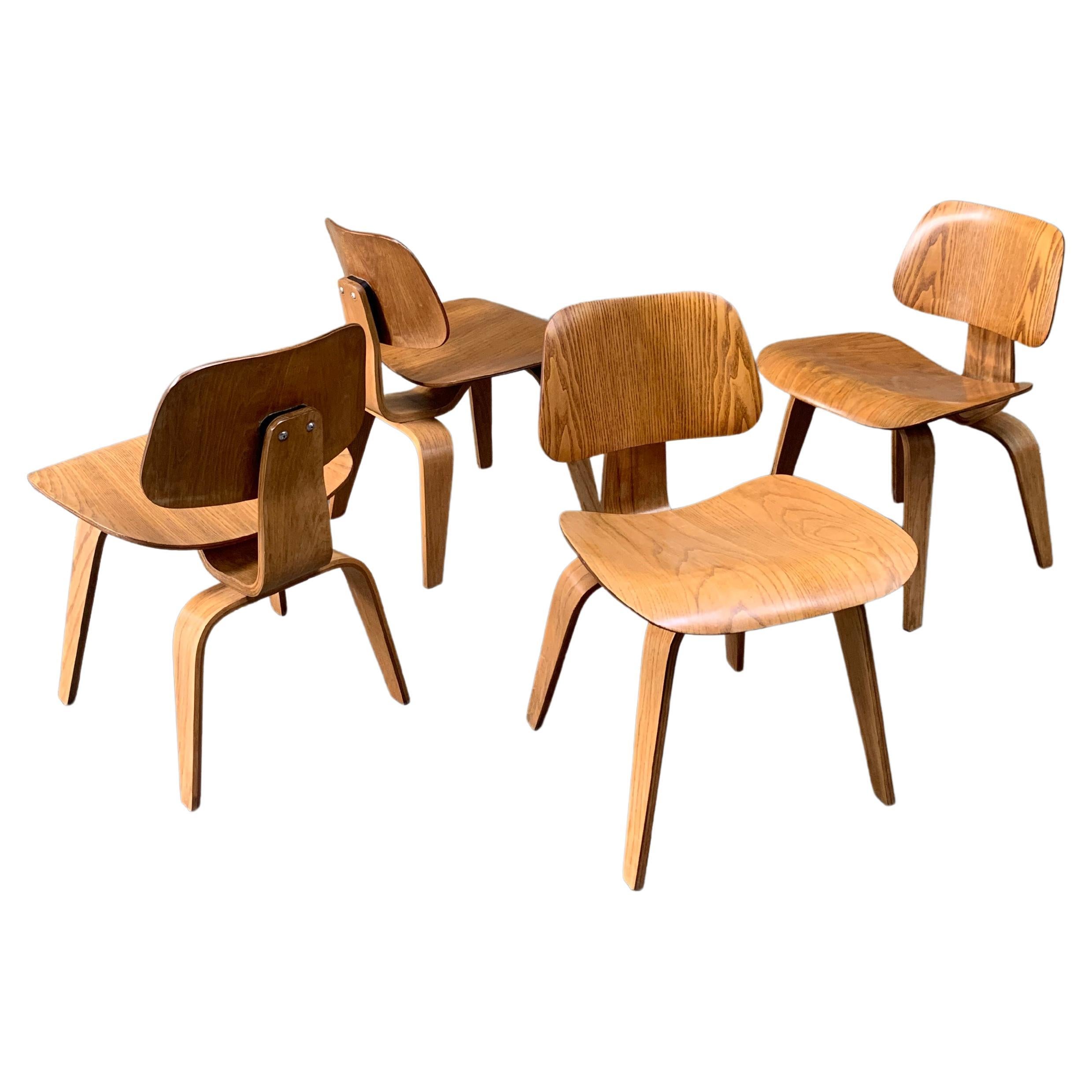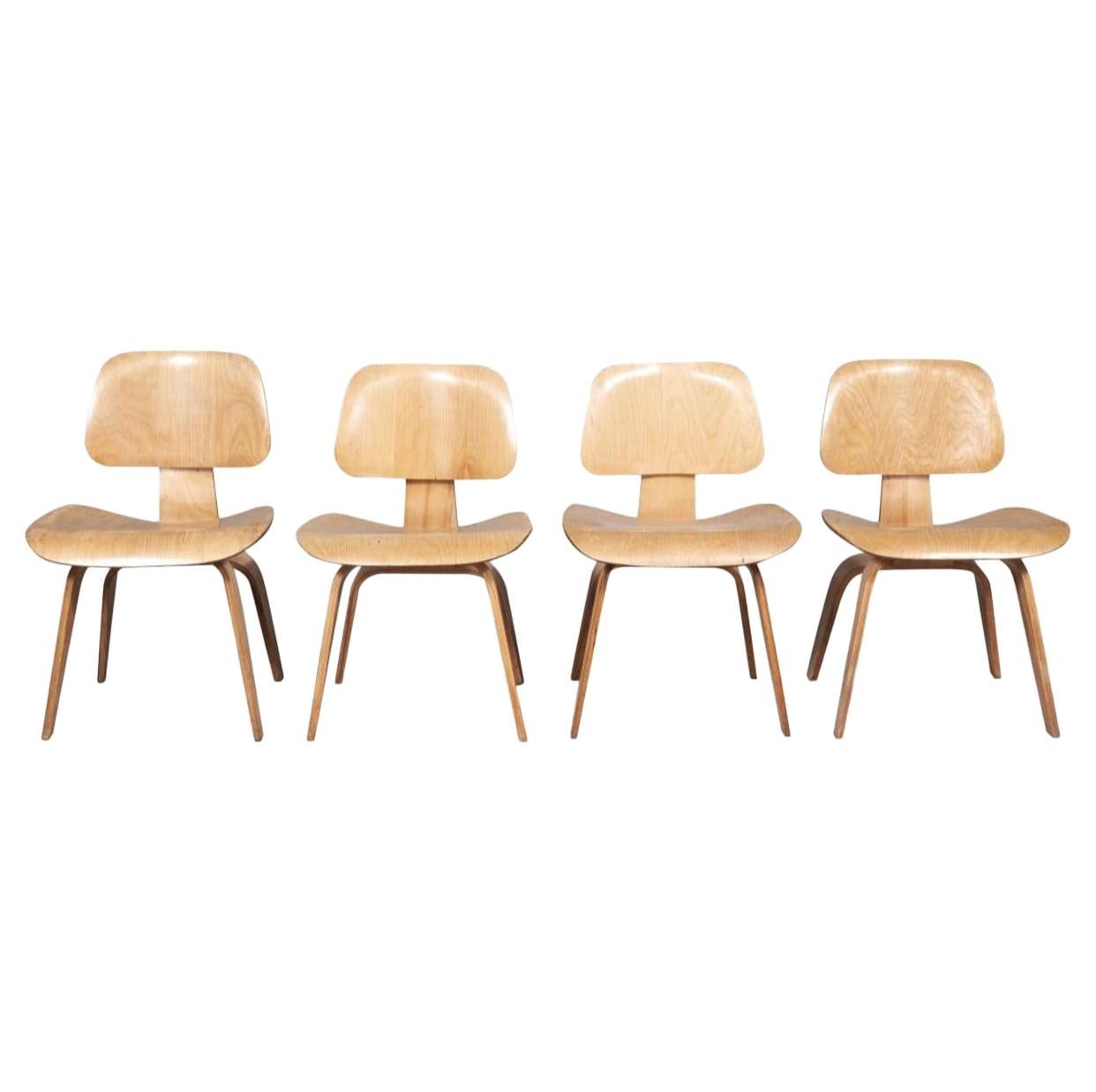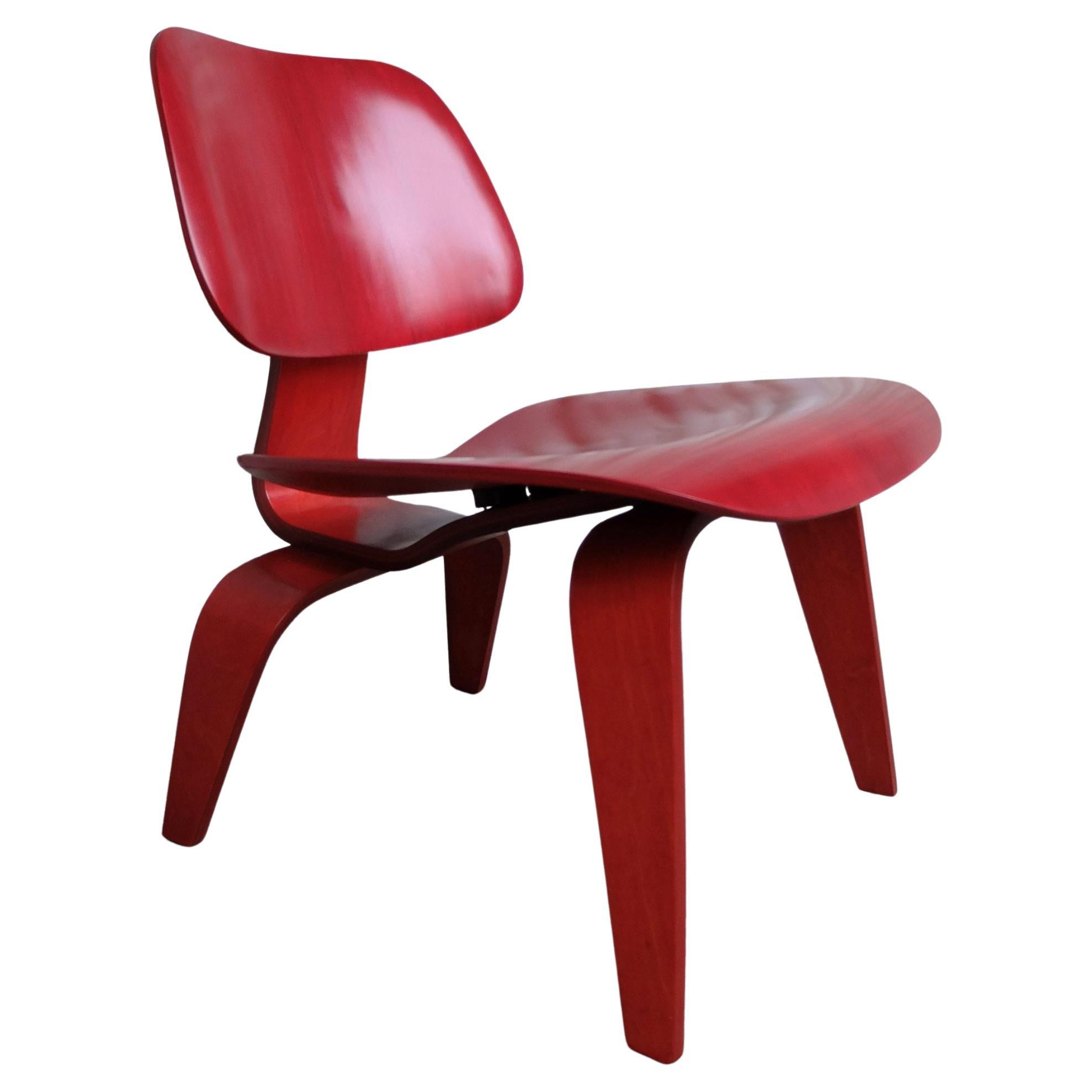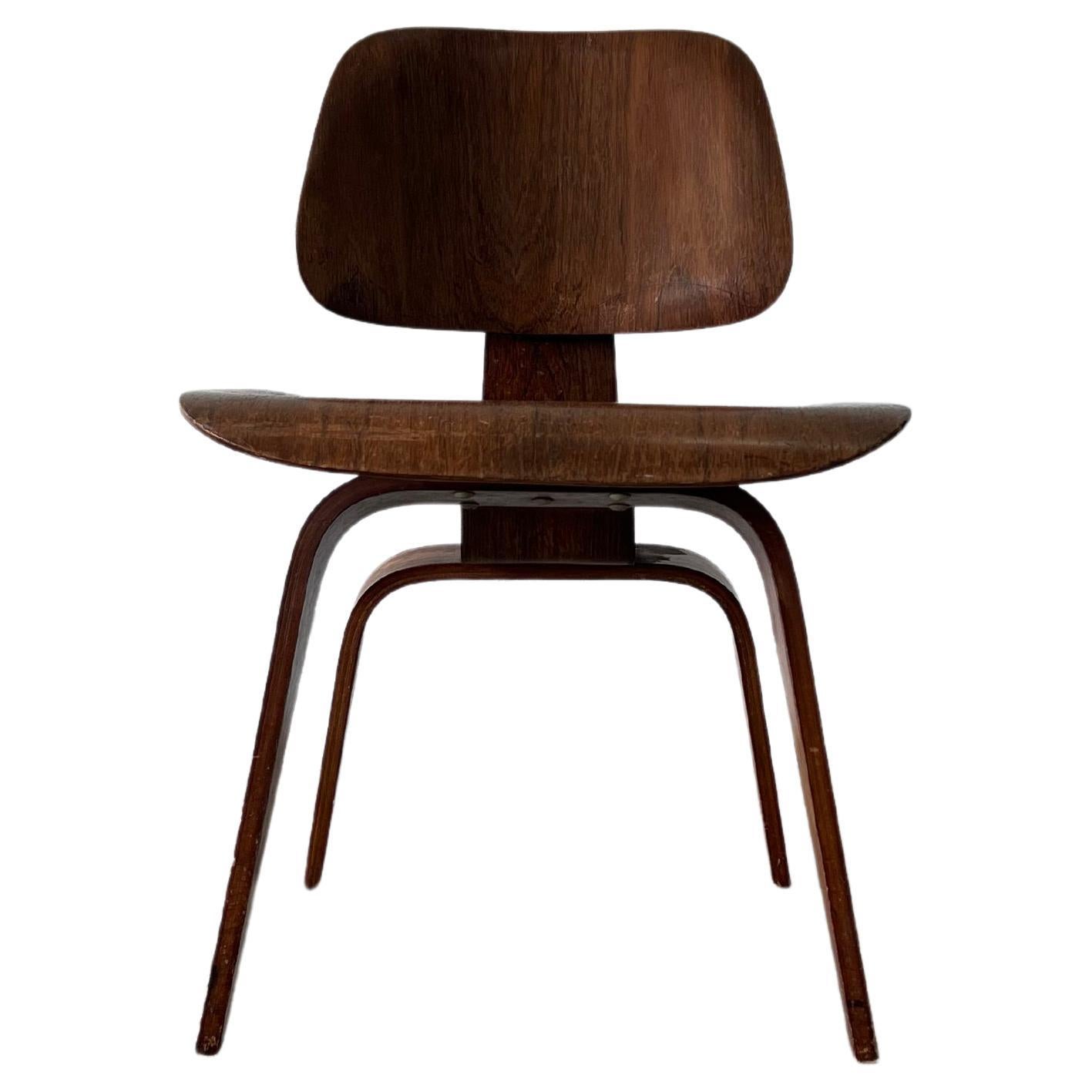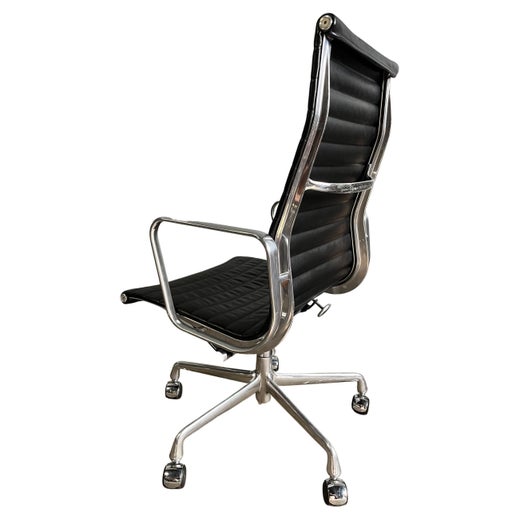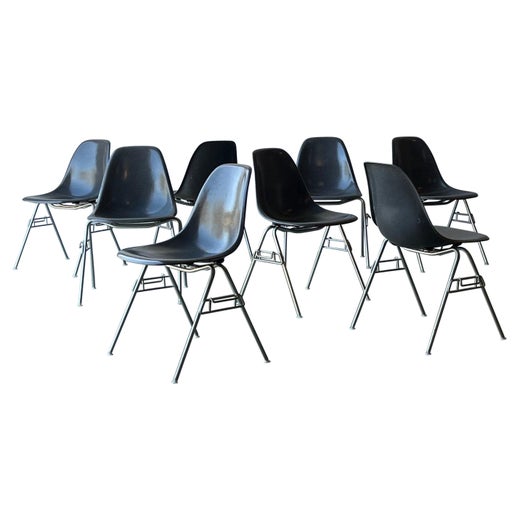Early DCW Dining Chair in Walnut by Charles & Ray Eames for Evans Plywood, 1940s
About the Item
- Creator:
- Dimensions:Height: 28.75 in (73 cm)Width: 19.3 in (49 cm)Depth: 21.66 in (55 cm)Seat Height: 17.33 in (44 cm)
- Style:Mid-Century Modern (Of the Period)
- Materials and Techniques:
- Place of Origin:
- Period:
- Date of Manufacture:1946-1948
- Condition:Wear consistent with age and use. Refinished.
- Seller Location:Vorst, BE
- Reference Number:1stDibs: LU7441236156462
Charles Eames
The legacy of Charles Eames looms large in design. In partnership with his wife, Ray, Charles was at the forefront of pioneering innovation in the use of molded plywood for furniture making. The Eameses’ cheerful and inviting work has endured among the most important advancements in the history of 20th-century design.
Together, visionary mid-century modern duo Charles and Ray Eames introduced a wide range of renowned furniture to the postwar market, including iconic designs such as the Eames lounge chair and ottoman, the wildly colorful birch plywood-and-plastic-laminate Eames storage unit, the Eames compact sofa and more. The designers were trailblazers in molded plywood furniture and brought lively organic form to metal and plastic.
Charles Eames studied architecture at Washington University in St. Louis. He traveled to Mexico and Europe, and experienced firsthand the work of designer-architects Le Corbusier and Ludwig Mies van der Rohe. In 1930, upon returning to Missouri, Eames opened an architecture practice with Charles M. Gray but later moved to Michigan in 1938. He received a fellowship at Cranbrook Academy of Art, which would become a breeding ground for the stars of mid-century design. Eames continued his architecture studies at Cranbrook and also taught in the design department.
In 1940, Eames met his future wife, artist and designer Beatrice Alexandra "Ray" Kaiser, who was studying at Cranbrook under Abstract Expressionist painter Hans Hofmann. Charles teamed up with another Cranbrook instructor, Finnish-American designer Eero Saarinen, to explore the possibilities of plywood for use in furniture design.
With support from Ray, Charles and Eero created chairs and case pieces and submitted them to the “Organic Design in Home Furnishings” competition at the Museum of Modern Art in New York City — among them was the groundbreaking organic Side chair made of molded plywood with maple legs. It was upholstered by Heywood-Wakefield. This exhibition is considered critical by many to the popularization of what is known as mid-century modernism. Eames and Saarinen won first place for their submissions to the competition.
Charles and Ray were married in 1941 and soon after moved to Los Angeles, California, and lived in an apartment building designed by architect Richard Neutra. Charles worked on set design at MGM, and at night, in a humble workshop they established in the guest bedroom, he and Ray experimented with molded plywood on a homemade device they called the “Kazaam!” machine. In 1942, the couple won a U.S. Navy contract to create molded plywood leg splints that would be used to support wartime medical efforts. Soon, the Evans Product Company was making the splints and the Eameses opened the famed Eames Office and studio.
The Eameses’ innovative use of wire framing, molded plywood and applied fabrics caught the attention of many notable figures in interior design and architecture, including George Nelson, director of design at Herman Miller, a now-legendary modern furniture manufacturer. The company enlisted the Eameses’ talents and was eventually home to the couple’s classic pieces such as the Eames DCW chair and the DCM chair.
Find an extensive array of vintage Charles Eames seating, tables and case pieces on 1stDibs.
Charles and Ray Eames
Charles Eames and Ray Eames were the embodiment of the inventiveness, energy and optimism at the heart of mid-century modern American design, and have been recognized as the most influential designers of the 20th century.
As furniture designers, filmmakers, artists, textile and graphic designers and even toy and puzzle makers, the Eameses were a visionary and effective force for the notion that design should be an agent of positive change. They are the happy, ever-curious, ever-adventurous faces of modernism.
Charles (1907–78) studied architecture and industrial design. Ray (née Beatrice Alexandra Kaiser, 1912–88) was an artist, who studied under the Abstract Expressionist painter Hans Hofmann. They met in 1940 at the Cranbrook Academy of Art in suburban Detroit (the legendary institution where Charles also met his frequent collaborator Eero Saarinen and the artist and designer Harry Bertoia) and married the next year.
His technical skills and her artistic flair were wonderfully complementary. They moved to Los Angeles in 1941, where Charles worked on set design for MGM. In the evenings at their apartment, they experimented with molded plywood using a handmade heat-and-pressurization device they called the “Kazam!” machine. The next year, they won a contract from the U.S. Navy for lightweight plywood leg splints for wounded servicemen — they are coveted collectibles today; more so those that Ray used to make sculptures.
The Navy contract allowed Charles to open a professional studio, and the attention-grabbing plywood furniture the firm produced prompted George Nelson, the director of design of the furniture-maker Herman Miller Inc., to enlist Charles and (by association, if not by contract) Ray in 1946. Some of the first Eames items to emerge from Herman Miller are now classics: the LCW, or Lounge Chair Wood, and the DCM, or Dining Chair Metal, supported by tubular steel.
The Eameses eagerly embraced new technology and materials, and one of their peculiar talents was to imbue their supremely modern design with references to folk traditions. Their Wire chair group of the 1950s, for example, was inspired by basket weaving techniques. The populist notion of “good design for all” drove their molded fiberglass chair series that same decade, and also produced the organic-form, ever-delightful La Chaise. In 1956 the Eames lounge chair and ottoman appeared — the supremely comfortable plywood-base-and-leather-upholstery creation that will likely live in homes as long as there are people with good taste and sense.
Charles Eames once said, “The role of the designer is that of a very good, thoughtful host anticipating the needs of his guests.” For very good collectors and thoughtful interior designers, a piece of design by the Eameses, the closer produced to original conception the better, is almost de rigueur — for its beauty and comfort, and not least as a tribute to the creative legacy and enduring influence of Charles and Ray Eames.
The collection of original Eames furniture on 1stDibs includes chairs, tables, case pieces and other items.
- ShippingRetrieving quote...Ships From: Alsemberg, Belgium
- Return PolicyA return for this item may be initiated within 14 days of delivery.
- Dcw Dining Chairs Ash by Charles & Ray Eames for Evans / Herman Miller, 1940sBy Herman Miller, Evans Products Company, Charles Eames, Charles and Ray EamesLocated in Vorst, BEDCW (dining chair wood) chairs In ash veneer. First generation chairs produced by Evans Products Company and distributed by Herman Miller between 19...Category
Mid-20th Century American Mid-Century Modern Dining Room Chairs
MaterialsAsh, Plywood
- Early LCW Lounge Chair stained red by Charles & Ray Eames, Evans Plywood, 1950sBy Evans Products Company, Charles Eames, Charles and Ray EamesLocated in Vorst, BELCW (Lounge Chair Wood) chair created by Charles and Ray Eames around 1945. Chair sold by Herman Miller, but produced by Evans Plywood in 1948-1949. The 5-2-5 screw arrangement bene...Category
Mid-20th Century American Mid-Century Modern Dining Room Chairs
MaterialsPlywood
- Pair early DCW Dining Chair in black by Charles & Ray Eames, Herman Miller 1950sBy Herman Miller, Charles Eames, Charles and Ray EamesLocated in Vorst, BEDCW (Dining Chair Wood) chair created by Charles and Ray Eames around 1945. These are second generation chairs produced by Herman Miller USA between 1950 and 1953 (the production of...Category
Mid-20th Century American Mid-Century Modern Dining Room Chairs
MaterialsWalnut, Plywood
- Early LCW Lounge Chair in Birch by Charles & Ray Eames, Herman Miller, 1950sBy Charles and Ray Eames, Herman Miller, Charles EamesLocated in Vorst, BEAn early LCW (Lounge Chair Wood) in Birch. Produced by Herman Miller between 1952 and 1958 (the production of the LCW has been stopped in 1958 until its re-introduction in 1994). ...Category
Mid-20th Century American Mid-Century Modern Lounge Chairs
MaterialsPlywood, Birch
- Early Grand Prix Dining Chairs in Teak, Arne Jacobsen for Fritz Hansen DenmarkBy Arne Jacobsen, Fritz HansenLocated in Vorst, BEFour Grand Prix chairs (model no. 4130) by Arne Jacobsen for Fritz Hansen, Denmark. The design received the highest award (thus the name “Grand Prix”) at the Triennale in Milan in ...Category
Mid-20th Century Danish Mid-Century Modern Dining Room Chairs
MaterialsTeak, Plywood, Beech
- Vintage Les Arcs Dining Chair Selected by Charlotte Perriand patinated LeatherBy Steph Simon, Charlotte Perriand, Jean Prouvé, Dal VeraLocated in Vorst, BEDining chair commissioned / selected by Charlotte Perriand for the interior design of the appartements of 'Les Arcs' Ski Resorts in the French Alps. Chromed tubular frame in metal p...Category
Mid-20th Century Italian Mid-Century Modern Dining Room Chairs
MaterialsSteel, Chrome
- Four 1940s Early Eames DCW Dining Chairs by Evans ProductsBy Evans Products Company, Charles and Ray EamesLocated in Brooklyn, NYRare set of four DCW dining chairs designed by Charles and Ray Eames and manufactured by Evans Products. These were produced in the 1940s before Herma...Category
Vintage 1940s Mid-Century Modern Dining Room Chairs
MaterialsBirch
- 1940s Vintage Evans Herman Miller Eames Rosewood Dcw 5-2-5 ChairBy Herman Miller, Evans Products Company, Charles and Ray EamesLocated in Saint Paul, MNThe first chair by Charles and Ray Eames, the DCW changed mid century modernism forever. This rosewood example, bears the uncommon Herman Miller/ Evans Products label.Category
Mid-20th Century American Mid-Century Modern Dining Room Chairs
MaterialsRosewood
- 1940s Vintage Evans Herman Miller Eames Ash Dcw 5-2-5 ChairBy Evans Products Company, Herman Miller, Charles and Ray EamesLocated in Saint Paul, MNThe first chair by Charles and Ray Eames, the DCW changed mid century modernism forever. This ash example is unmarked but has the 5-2-5 screw pattern that is documented and well know...Category
Mid-20th Century American Mid-Century Modern Dining Room Chairs
MaterialsAsh
- Charles & Ray Eames for Herman Miller Plywood DCW Dining Chairs, 1950s Set of 2By Charles and Ray Eames, Herman MillerLocated in London, GBThe DCW chair was originally released in 1946, with Herman Miller taking over the manufacture of the chairs in 1950. This lasted until 1953 when the chairs were taken out of producti...Category
Vintage 1950s American Mid-Century Modern Dining Room Chairs
MaterialsPlywood
- Plywood Dining Chairs Charles + Ray EamesBy Charles EamesLocated in Los Angeles, CAclassic California design Herman Miller manufacturer mixed woods, birch, ash and walnut unfortunately, they were once painted black they've been restored back to natural satin wi...Category
Antique Mid-19th Century American Mid-Century Modern Dining Room Chairs
MaterialsWood
- Mid-Century 1940s Walnut DCW Plywood Chair by Charles & Ray Eames Herman MillerBy Herman Miller, Charles and Ray EamesLocated in Las Vegas, NV1940s Brown walnut DCW plywood chair by Charles & Ray Eames Herman Miller Beautiful and really rare early DCW chair designed by Charles & Ray Eames. The chair is made out of walnu...Category
Vintage 1940s Chairs
MaterialsPlywood, Walnut
Recently Viewed
View AllRead More
The 21 Most Popular Mid-Century Modern Chairs
You know the designs, now get the stories about how they came to be.
A Guide to Herman Miller’s Most Iconic Furniture
The prolific manufacturer has partnered with many of the world’s top designers since opening its doors in 1923. Here are some of the company’s greatest hits, which helped transform the American home and office.
